CBSE Class 12 Physics Chapter 10 Wave Optics Multiple Choice Questions And Answers
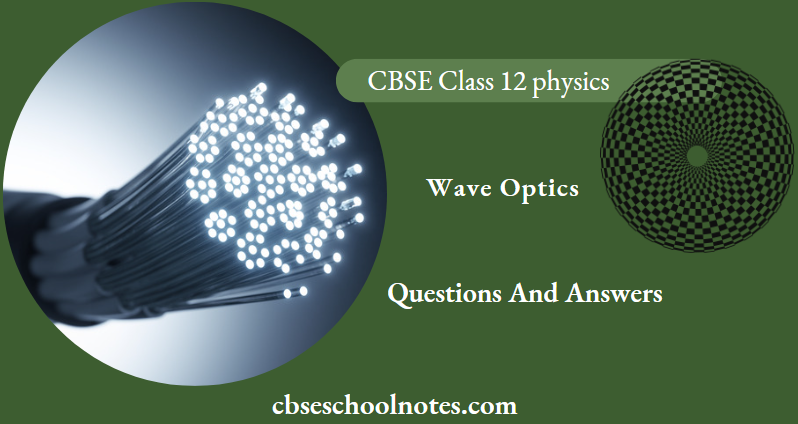
Question 1. The distance between two slits in Young’s experiment is 0.2 mm. If the wavelength of the light used is 5000 Å, the angular position of the 5th dark fringe from the central bright fringe is _________ rad.
- 0.11
- 1.1
- 0.012
- 0.0011
Answer: 3. 0.11
Read and Learn More Important Questions for Class 12 Physics with Answers
⇒ \(y_n=\frac{5 \lambda D}{d}\)
Angular position,
⇒ \(\theta_n=\frac{n \lambda}{d}\)
∴ \(\theta_5=\frac{5 \lambda}{d}=\frac{5 \times 5000 \times 10^{-10}}{0.2 \times 10^{-3}}\)
Question 2. The angular spread of the central maximum, in the diffraction pattern, does not depend on _________.
- The Distance between the slit and the sources
- Wavelength of light
- Width of slit
- Frequency of light
Answer: 1. The Distance between the slit and the sources
Question 3. In Young’s double-slit experiment, the width of the source slit is increased then _______.
- The fringe pattern gets sharper and sharper
- Instead of interference, diffraction appears
- The angular distance between fringes increased
- Fringe pattern gels less and less sharp
Answer: 4. Fringe pattern gels less and less sharp
Question 4. In a two-slit experiment, the screen is placed one meter away. When light of wavelength 500 nm is used the fringe separation is 0.5 mm. The distance between two slits is ________ mm.
- 2
- 5
- 1
- 4
Answer: 3. 1
⇒ \(\beta=\frac{\lambda \mathrm{D}}{\mathrm{d}}\)
⇒ \(\mathrm{d}=\frac{\lambda \mathrm{D}}{\beta}=\frac{500 \times 10^-9 \times 1}{0.5 \times 10^{-3}}\)
∴ d = 10-3 m = 1nm
Question 5. If the phase difference between two waves is 6π radian, then the corresponding path difference is _________.
- 6λ
- λ
- 2λ
- 3λ
Answer: 4. 3λ
⇒ \(\frac{\Delta x}{\lambda}=\frac{\phi}{2 \pi}\)
⇒ \(\Delta x=\frac{6 \pi}{2 \pi} \times \lambda\)
∴ Δx = 3λ
Question 6. The intensity of a result wave obtained by the superposition of two waves is _______ amplitude of the resultant wave.
- Directly proportional to the cube of
- Directly proportional to
- Directly proportional to the square of
- Directly proportional to the square root of
Answer: 3. Directly proportional to the square of
CBSE Class 12 Physics Chapter 10 Wave Optics Assertion And Reason
For question numbers 1 to 5, two statements are given: Assertion (A) and Reason (R). Select the correct answer to these questions from the codes (1), (2), (3) and (4) as given below.
- Both A and R are true and R is the correct explanation of A
- Both A and R are true but R is NOT the correct explanation of A
- A is true but R is false
- A is false and R is also false
Question 1. Assertion: If white light is used in YDSE, the central bright fringe will be white.
Reason: Because all the wavelengths produce their zero-order maxima at the same position.
Answer: 1. Both A and R are true and R is the correct explanation of A
Question 2. Assertion: Diffraction of sound waves is more easily observed than light waves.
Reason: Wavelength of sound waves is more as compared to light.
Answer: 1. Both A and R are true and R is the correct explanation of A
Question 3. Assertion: In interference light energy is redistributed.
Reason: There is no gain or loss of energy, which is consistent with the principle of energy conservation.
Answer: 1. Both A and R are true and R is the correct explanation of A
Question 4. Assertion: No interference pattern is detected when two coherent sources are infinitely close to each other.
Reason: The fringe width is inversely proportional to the distance between the two slits.
Answer: 1. Both A and R are true and R is the correct explanation of A
Question 5. Assertion: In Young’s experiment, the fringe width for dark fringes is different from that for white fringes.
Reason: In Young’s double slit experiment the fringes arc formed with a source of white light then only black and bright fringes are observed.
Answer: 4. A is false and R is also false
CBSE Class 12 Physics Chapter 10 Wave Optics Short Questions And Answers
Question 1. Explain the formation of the fringes due to diffraction at a single slit, when the path difference of light waves from the ends of the slit on reaching a point on the screen is
- λ
- \(\frac{3 \lambda}{2}\)
Answer:
- When the path difference is λ. then we get the first minima on screen.
- When the Path difference is \(\frac{3 \lambda}{2}\) then we get the first secondary maxima on screen.
Question 2. How would the angular width of the central maximum of diffraction pattern be affected when
- The width of the slit is decreased, and
- Monochromatic light is replaced by polychromatic light. Justify your answers.
Answer:
In diffraction
⇒ \(\theta=\frac{2 \lambda}{d}\)
- Angular width will increase \(\theta \propto \frac{1}{d}\)
- The diffracted image gets dispersed into constituent colours of white light.
Question 3. Compare the interference pattern observed in Young’s double-slit experiment with the single-slit diffraction pattern, pointing out three distinguishing features.
Answer:

Question 4. Define the term wavefront. State Huygen’s principle. Consider a plane wave front incident on a thin convex lens. Draw a proper diagram to show how the incident wave from transverse through the lens and after refraction focuses on the focal point of the lens, giving the shape of the emergent wavefront.
Answer:
Wavefront: The Locus of all the points vibrating in the same phase is called wavefront.
Huygens Principle states that every point on a wavefront is a source of new disturbance which travels further in the form of secondary wavelets. These wavelets spread out in the forward direction at the same speed as the source wave. A new wavefront is a tangential surface to the secondary wavelets.
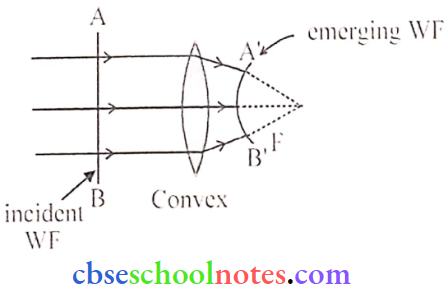
Question 5.
- Derive Snell’s law on the basis of Huygens wave Ihcory when light is travelling from a denser to a rarer medium.
- Draw the sketches to differentiate between plane wavefront and spherical wavefront.
Answer:

Proof of SNELL’S Law:
Consider a plane wavefront (AB) incident on the surface XY. separating two media. Let the secondary wavelets from point (B) reach up to point (C) in lime (t). So draw an arc of length (v2t) from point A to locate the position of refracted WF. Now we draw a tangent (CD) on this arc where CD represents refracted WF.
Incident ray, refracted ray & the normal arc respectively1 to incident WF. refracted WF and surface XY.
Also, \(\sin \mathrm{i}=\frac{\mathrm{BC}}{\mathrm{AC}}=\frac{v_1 t}{A C}\) → (1)
and \(\sin r=\frac{A D}{A C}=\frac{v_2 t}{A C}\) → (2)
From (1) and (2)
∴ \(\frac{v_1}{v_2}=\frac{\sin i}{\sin r}\)
Or \(\frac{\mu_2}{\mu_1}=\frac{\sin i}{\sin r}\)
Hence Snell’s law is proved
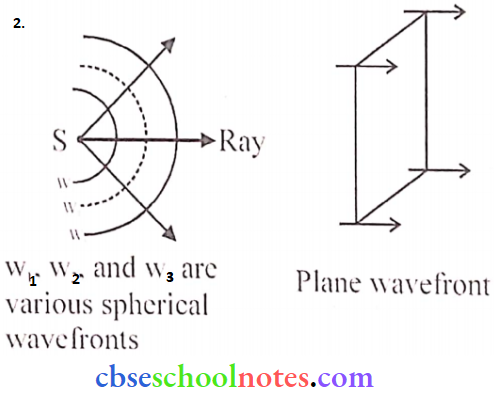
Question 6.
- In Young’s double slit experiment, two slits arc I mm apart and the screen is placed 1 m away from the slits. Calculate the fringe width when light of wavelength 500 nm is used.
- What should be the width of each slit to obtain 10 maxima of the double slit pattern within the central maximum of the single slit pattern?
Answer:
d = 1 mm, D = I m, λ = 500 nm (given)
∴ \(\beta=\frac{\lambda \mathrm{D}}{\mathrm{d}}=\frac{500 \times 10^{-9} \times 1}{10^{-3}} \mathrm{~m}=500 \times 10^{-6} \mathrm{~m}=500 \mu \mathrm{m}\)
2. In single slit diffraction, path diff. = a sinθ ≅ aθ = X ⇒ θ = λ/a
Width of central maxima of single slit = 2λ/a
Width of 10 maxima = 10 x fringe spacing = 10 x λ/6
Width of central maximum of single slit = Width of 10 maxima of double slit
∴ \(\frac{10 \lambda}{d}=\frac{2 \lambda}{a} \Rightarrow a=\frac{d}{5}=0.2 \mathrm{~mm}\)
Question 7. Two harmonic waves of monochromatic light y1 = a cos ωt and y2 = a cos(ωt +Φ) are superimposed on each other. Show that the maximum intensity in the interference pattern is four times the intensity due to each slit. Hence write the conditions for constructive and destructive interference in terms of the phase angle Φ.
Answer:
Given, y, = a cos ωt, y, = a cos(ωt + Φ)
Resultant displacement is given as:
y = y1 +y2
= a cos ωt + a cos(ωt + Φ)
= a cos ωt + a cos ωt cos Φ – a sin ωt sin Φ
= a cos ωt (1+ cos Φ)- a sin ωt sin Φ
Put R cos θ = a (1 + cos Φ) → (1)
R sin θ = a sin Φ → (2)
By squaring and adding Eqs. (1) and (2), we get
R2 = a2(1+cos2Φ + 2cosΦ) + a2sin2Φ – 2a2( 1 + cos Φ ) = 4a2cos2Φ/2
∴ \(I=R^2=4 a^2 \cos ^2 \frac{\phi}{2}=4 I_0 \cos ^2 \frac{\phi}{2}\)
1. For constructive interference,
∴ \(\cos \frac{\phi}{2}= \pm 1 \text { or } \frac{\phi}{2}=n \pi \text { or } \phi=2 n \pi, n=0,1,2 \ldots\)
2. For destructive interference,
∴ \(\cos \frac{\phi}{2}=0 \text { or } \frac{\phi}{2}=(2 n+1) \frac{\pi}{2} \text { or } \phi=(2 n+1) \pi, n=0,1,2 \ldots\)
Question 8.
- If one of two identical slits producing interference in Young’s experiment is covered with glass, so that the light intensity passing through it is reduced to 50%, find the ratio of the maximum and minimum intensity of the fringe in the interference pattern.
- What kind of fringes do you expect to observe if white light is used instead of monochromatic light?
Answer:
1. Let the intensity through one of the slits be I1 =1.
So. intensity of light through the slit covered by glass
I2 = 0.5I
Maximum intensity \(I_{\max }=\left(\sqrt{I_1}+\sqrt{I_2}\right)^2\)
⇒ \(I_{\mathrm{max}}=(\sqrt{\mathrm{I}}+\sqrt{0.5 \mathrm{I}})^2=2.9 \mathrm{I}\)
Minimum Intensity = \(I_{\min }=\left(\sqrt{I_1}-\sqrt{I_2}\right)^2\)
⇒ \(I_{\min }=(\sqrt{I}-\sqrt{0.5 I})^2=0.086 I\)
Thus ratio of intensities \(\frac{I_{\max }}{I_{\min }}=\frac{2.9}{0.086}=33.8\)
2. If white light is used in place of monochromatic light, then the central fringe will be white and some coloured fringes will be seen adjacent to the central fringe.
Question 9. Explain the following, giving reasons:
- When monochromatic light is incident on a surface separating two media, the reflected and refracted light both have the same frequency as the incident frequency.
- When light travels from a rarer to a denser medium, the speed decreases, does this decrease in speed imply a reduction in the energy carried by the wave?
- In the wave picture of light, the intensity of light is determined by the square of the amplitude of the wave. What determines the intensity in the photon picture of light?
Answer:
- Reflection and refraction arise through the interaction of incident light with the atomic constituents of matter. Atoms may be viewed as oscillators, which light up the frequency of the external agency (light) causing forced oscillations. The frequency of emitted light by a charged oscillator equals to its freq. of oscillation. Thus, the frequency of scattered light equals the frequency of incident light.
- No, the energy carried by a wave depends on the amplitude of the wave, not on the speed of
wave. - For a given frequency, the intensity of light in the photon picture is determined by the no. of photons lulling on unit area per unit time.
Question 10. Monochromatic light of wavelength 600 nm is incident from air on a water surface. The refractive index of water is 1.33. Find the
- Wavelength,
- Frequency and
- Speed, of reflected and refracted light.
Answer:
Given: X = 600 nm, \(\mathrm{n}_{\mathrm{w}}=\frac{4}{3}=1.33\)
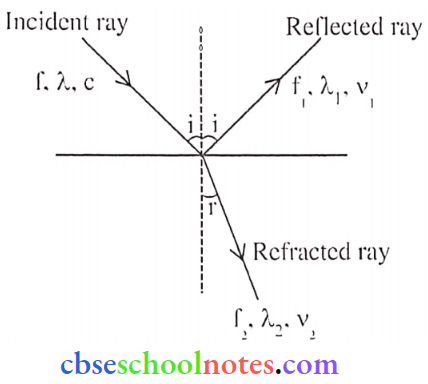
Frequency of incident ray
⇒ \(c=f \lambda \Rightarrow f=\frac{c}{\lambda}=\frac{3 \times 10^8}{600 \times 10^{-10}}\)
f = 5 x 1014 Hz
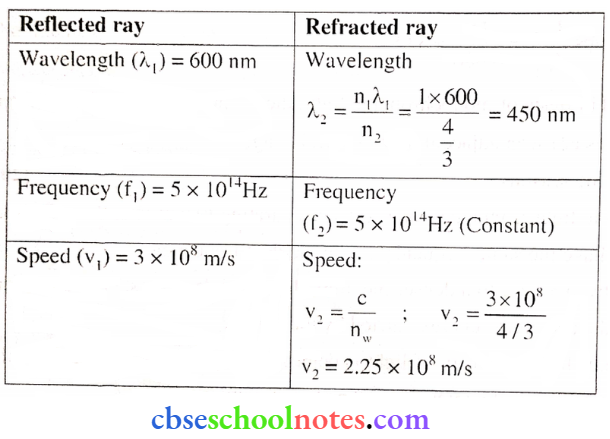
Question 11.
- Stale two conditions for two light sources to be coherent.
- Give two points of difference between an interference pattern due to a double-slit and a diffraction pattern due to a single slit.
Answer:
- Two sources are said to be coherent if-
- These produce waves of the same frequency with
- Constant or zero phase difference
- Interference is the result of the superposition of secondary wavelets from two different slits while diffraction results due to the superposition of secondary wavelets from different parts of the same source slit.
- In the interference pattern, all maxima are equally bright while in the case of diffraction, maxima are of decreasing intensity.
Question 12. How is the spacing between fringes in a double slit experiment affected if:
- The slits separation is increased.
- The colour of light used is changed from red to blue.
- The whole apparatus is submerged in an oil with a refractive index of 1.2.
Justify your answer in each case
Answer:
Spacing between fringes in a double slit experiment is given by \(\beta=\frac{\lambda \mathrm{D}}{\mathrm{d}}\)
Where, λ => Wavelength of light; d ⇒ Slit separation; D ⇒ Distance between slit and screen
On increasing *d’ fringe width decreases
λred > λblue. So ‘β’ decreases.
When the whole apparatus is immersed in oil of refractive index 1 .2. the wavelength decreases.
∴ \(\lambda^{\prime}=\frac{\lambda}{1.2}\)
∴ \(\beta^{\prime}=\frac{\lambda^{\prime} \mathrm{D}}{\mathrm{d}}\)= \(\beta^{\prime}=\frac{\beta}{1.2}\)
It means fringe width decreases.
CBSE Class 12 Physics Chapter 10 Wave Optics Long Questions and Answers
Question 1. Wavefront is a locus of points which vibrates in the same phase. A ray of light is perpendicular to the wavefront. According to Huygens principle, each point of the wavefront is the source of a secondary disturbance and the wavelets connecting from these points spread out in all directions with the speed of the wave. The figure shows a surface XY separating two transparent media. medium- 1 and medium-2. The lines ah and cd represent wavefronts of a light wave\e tra\elling in medium- 1 and incident on XY. The lines of and gh represent wavefronts of the light wa\c in medium -2 after refraction.
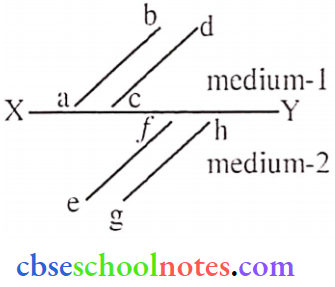
(1). Light travels as a
- Parallel beam in each medium
- Convergent beam in each medium
- Divergent beam in each medium
- Divergent beam in one medium and convergent beam in the other medium
Answer: 1. Parallel beam in each medium
(2). The phases of the light wave at c, d, c and f are Φc, Φd, Φe, and Φf respectively. It is given that Φc = Φf
- Φc can not be equal to Φd
- Φd can be equal to Φe
- (Φd – Φf) is equal to (Φc– Φe)
- (Φd– Φc ) is not equal to (Φf – Φe)
Answer: 3. (Φd – Φf) is equal to (Φc– Φe)
(3). Wavefront is the locus of all points, where the particles of the medium vibrate with the same
- Phase
- Amplitude
- Frequency
- Period
Answer: 1. Phase
(4). A point source that emits waves uniformly in all directions, produces wavefronts that are
- Spherical
- Elliptical
- Cylindrical
- Planar
Answer: 1. Spherical
Question 2.
- Define a wavefront. Using Huygens principle, verify the laws of reflection at a plane Surface
- In a single slit diffraction experiment, the width of the slit is made double the original width. How does this affect the size and intensity of the central diffraction band? Explain.
- When a tiny circular obstacle is placed in the path of light from a distant source, a bright spot is seen at the centre of the obstacle. Explain why?
Answer:
1. The wavefront is defined as a surface of constant phase.
(Alternatively: The wavefront is the locus of all points in the same phase).

Let the speed of the wave in the medium be ‘v’
Let the time taken by the wavefront, to advance from point B to point C is ‘τ’
Hence BC = vτ
Let CE represent the reflected wavefront. Distance AE = vτ = BC
Δ AEC and Δ ABC are congruent
∴ ∠ABC = ∠AEC(90°)
AC = AC
AE = BC.
So, ∠BAC = ∠ECA (by corresponding part of congruent triangles)
= ∠i = ∠r (proved)
2. If the width of the slit is made double then the size of the central maxima reduces to half and intensity increases upto four times.
3. This is because of the diffraction of light.
[Alternatively: Light gels diffracted by the tiny circular obstacle and reach the centre of the shadow of the obstacle.]
[Alternatively: There is a maxima, at the centre of the obstacle, in the diffraction pattern produced by it.]
Question 3.
- Give an expression for path difference in Young’s double slit experiment and obtain the conditions for constructive and destructive interference at a point on the screen.
- The intensity at the central maxima in Young’s double-slit experiment is I0. Find out the intensity at a point where the path difference is \(\frac{\lambda}{6},\frac{\lambda}{4} \text { and } \frac{\lambda}{3}\)
Answer:
1. Conditions for interference of light:
- Both sources of light must be coherent.
- Both sources of light should be monochromatic.
Expression for fringe width in Young’s double slit experiment:
Path difference between the light waves reaching point P from S1 and S2
Δx = S2P -S1P
Path difference \((\Delta \mathrm{x})=\frac{\mathrm{y}_{\mathrm{n}} \mathrm{d}}{\mathrm{D}}\)
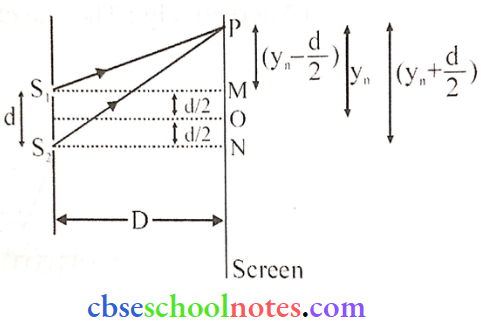
Case (1) Position of bright fringes:
If nth bright fringe occurs at point P. then the path difference
Δx = nλ
∴ \(\frac{y_n d}{D}=n \lambda \Rightarrow y_n=\frac{n \lambda D}{d} \text { where } n=0,1,2,3, \ldots .\)
yn ⇒ position of nth bright fringe on screen from the central bright fringe.
Case (2) Position of dark fringes:
Path difference for nth dark fringe
Δx = (2n – I )λ/2
⇒ \(\frac{y_n^{\prime} d}{D}=(2 n-1) \lambda/2\)
⇒ \(y_n^{\prime}=\frac{(2 n-1) \lambda D}{2 d} \text { where } n=1,2,3, \ldots .\)
y’n ⇒ position of nth dark fringe.
Fringe width:
The distance between two consecutive bright or dark fringes is called fringe width.
fringe width \((\beta)=y_{n+1}-y_n\) (Taking Condition for bright fringe \(y_n=\frac{n{\lambda}D}{\mathrm{d}}\))
⇒ \(\beta=\frac{(n+1)\lambda D}{d}-\frac{n \lambda D}{d}\)
∴ \(\beta=\frac{\lambda D}{d}\)
Intensity distribution curve:

2. As we Know, I = 4I0 Cos2(Φ/2)
Φ = Phase difference
⇒ \(\phi=\frac{2 \pi}{\lambda} \cdot \Delta x\) (Δx = path diff.)
(1) From, \(\phi=\frac{2 \pi}{\lambda} \cdot \Delta x=\frac{2 \pi}{\lambda} \cdot \frac{\lambda}{6}\)
Φ = π/3 = 60°
So, \(I=4 I_0 \cos ^2 30^{\circ}=4 I_0 \cdot \frac{3}{4}\)
I = 3I0
(2). From \(\phi=\frac{2 \pi}{\lambda} \cdot \Delta x=\frac{2 \pi}{\lambda} \cdot \frac{\lambda}{4}=\frac{\pi}{2}=90^{\circ}\)
So, \(I=4 I_0 \cos ^2 45^{\circ}=4 I_0 \cdot \frac{1}{2}\)
I = 2 I0
(3). From, \(\phi=\frac{2 \pi}{\lambda} \cdot \Delta x=\frac{2 \pi}{\lambda} \cdot \frac{\lambda}{3}=\frac{2 \pi}{3}=120^{\circ}\)
So, \(I=4 I_0 \cos ^2 60^{\circ}=4 I_0 \cdot \frac{1}{4}\)
I = I0
Question 4.
- State the essential conditions for diffraction of light.
- Explain the diffraction of light due to a narrow single slit and the formation of a pattern of fringes on the screen.
- Find the relation for the width of central maximum in terms of wavelength ‘λ’ width of slit ‘a’, and separation between slit and screen ‘D’.
- If the width of the slit is made double the original width, how does it affect the size and intensity of the central band?
Answer:
1. The wavelength of light should be comparable to the site of the obstacle,
2. Suppose a plane wavefront is incident on a slit AH (of width b), every part of the exposed part of the plane wavefront (i.e., every part of the slit) acts as a source of secondary wavelets spreading in all directions.
The diffraction is obtained on a screen placed at a large distance. (In practice, this condition is achieved by placing the screen at the focal plane of a converging lens placed to alter the slit).

- The diffraction pattern consists of a central bright fringe (central maxima) surrounded by dark and bright lines (called secondary minima and maxima).
- At point 0 on the screen, the central maxima is obtained. The wavelets originating from points A and B meet in the same phase at this point, hence at 0, intensity is maximum.
Secondary minima
For obtaining nth secondary minima at P on the screen, the path difference between the diffracted waves Δ = b sinθ = nλ (n = 0,1, 2, … )
Angular position of nth secondary minima
⇒ \(\sin \theta \simeq 0=\frac{n {\lambda}}{b}\)
Distance of nth secondary minima from central maxima
⇒ \(x_n=D \cdot \theta=\frac{n \lambda D}{b}=\frac{n \lambda f}{b}\)
where D = distance between slit and screen.
f ≅ D = Focal length of converging lens.
Secondary maxima:
For nth secondary maxima at P on the screen.
Path difference. \(\Delta=b \sin \theta =(2 n+1) \frac{\lambda}{2}\); where n = 1,2,3….
Angular position of nth secondary maxima
∴ \(\sin \theta \simeq \theta=\frac{(2 n+1) \lambda}{2 b}\)
Distance of nth secondary maxima,from central maxima
∴ \(x_n=D \cdot \theta=\frac{(2 n+1) \lambda D}{2 b}=\frac{(2 n+1) \lambda f}{2 b}\)

3. The Central Maximum:
The width of the central maximum is simply the distance between the 1st order minima from the centre of the screen on both sides of the centre.
The position of the minima given by ‘y’ (measured from the centre of the screen) is:
The position of the minima given by ‘y’ (measured from the centre of the screen) is:
∴ \(\tan \theta \simeq \theta=\frac{y}{D}\)
For small θ, sinθ ≅ θ
λ = bsinθ – bθ
⇒ \(\theta=\frac{y}{D}=\frac{\lambda}{b}\)
⇒ \(y=\frac{\lambda D}{b}\)
The width of the central maximum is simply twice this value width of central maximum = \(2 \frac{\lambda D}{b}\)
angular width of central maximum = 2θ = \(2 \frac{\lambda}{b}\)
4. If the width of the slit is made double then the size of the central maxima reduces to half and intensity increases upto four times.
